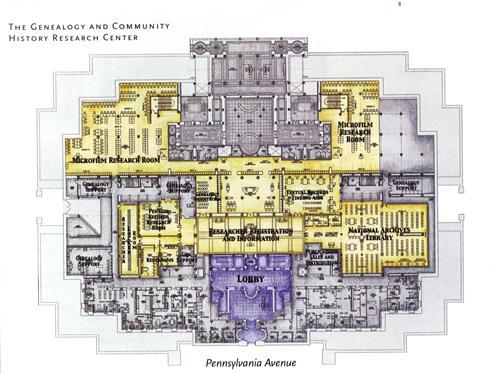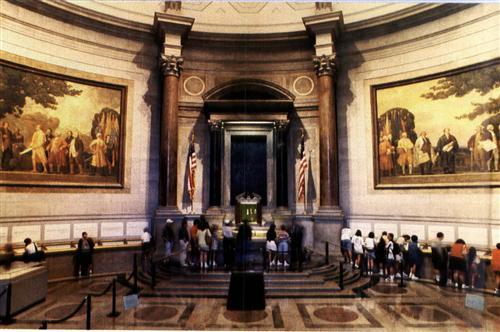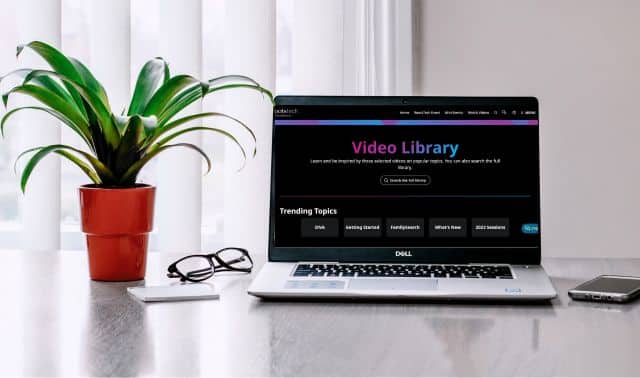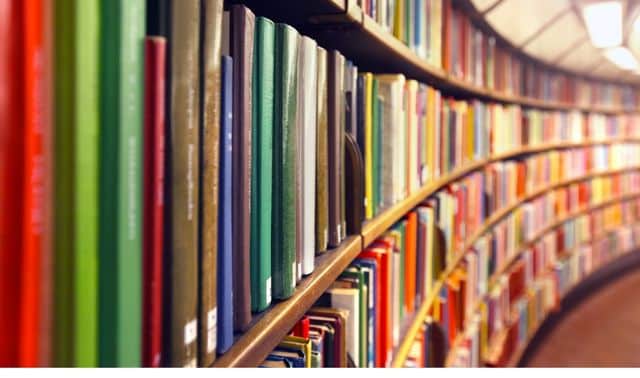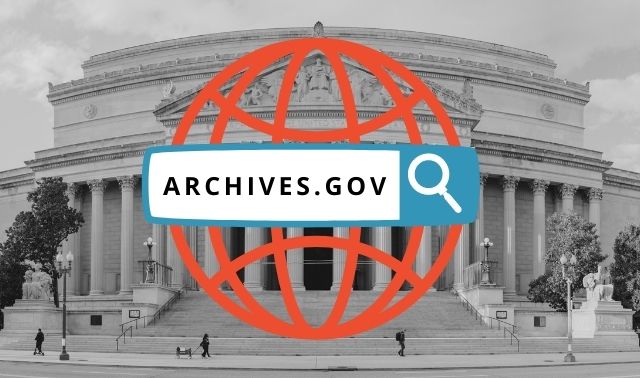Every good genealogy search begins at home. But when you’ve tapped all the local, family and regional sources you can, it’s time to take your research to the next level. After all, your ancestors were more than just farmers, small-town families or big-city immigrants. They were also residents of the United States, and whether they were citizens or aliens, soldiers or homesteaders, the US government kept tabs on them. Where will you find those records today? The National Archives and Records Administration (NARA) houses most of them in its Archives I building located in Washington, DC.
There you’ll find US censuses, military pensions and service records, passenger arrival records, homestead records, military headstone applications, bounty land warrants, Bureau of Indian Affairs records, Freedmen’s Bureau records, Court of Claims files, border crossing records and many others. While the records seem endless, however, not everything ever created by the federal government is kept there. The National Archives of the United States wasn’t established until 1934, and the building at 700 Pennsylvania Ave. NW opened in 1935. Many US records were created long before there was a National Archives, and some of them no longer exist. Still, NARA houses many federal documents dating to the 18th century. More records continue to be turned over to NARA all the time. Others are stored at NARA’s 13 regional facilities, as well as at the Archives II building in College Park, Md., the Veterans Administration, presidential libraries and other US repositories. (Look for details and links to these repositories at <www.archives.gov>.) As professional genealogy researchers, my husband and I travel to Washington, DC, to research at the National Archives for many weeks each year. With its thousands of records and complex research system, it may seem like a labyrinth to the first-time visitor. I’ll take you through all the steps of a genealogy researcher at the archives, and by the time we’re done, you’ll feel like an old pro — ready to visit the nation’s capital and confidently conquer the next level of your research.
Why go?
Some of NARA’s records are on microfilm and are available at its regional facilities, the Family History Library in Salt Lake City <www.familysearch.org>, and state and local repositories. They may also be borrowed from the National Archives microfilm rental program. But other in-house microfilms aren’t available elsewhere. And for some family historians, the real gem is research in textual records: manuscripts that can’t be found anywhere else. Imagine holding your great-great-grandfather’s original Civil War Union pension record, or your grandmother’s letter to the Bureau of Indian Affairs asking what happened to the aid promised for her reservation. Beyond the thrill of seeing your ancestor’s handwriting or an official record of his military service, these kinds of federal records might also give you a spouse’s name, a list of children or a previous residence. In some cases, you can do this only by visiting the archives yourself.
Plus, there is the archives’ location. Did you notice the address for Archives I? You might have heard of another address on that street, 1600 Pennsylvania Ave., where a big, white mansion sits. That’s just blocks away from the archives. And if you look the other way down Pennsylvania Avenue, you’ll see the domed US Capitol. Washington, DC, is full of history, so be sure to read one or more travel guidebooks before going there. Save some time during your visit to take a tour of the city and see its museums and monuments. (For more on visiting Washington, DC, see the new Family Tree Guide Book, coming to bookstores later this fall from Betterway Books, $19.99.)
A virtual tour
Before you visit, drop by the virtual home of the National Archives, <www.archives.gov>. This recently redesigned site offers lots of helpful information about the archives, its holdings and how to prepare for an on-site visit. Highlights include:
• a virtual Research Room for genealogists
• an alphabetical index to the most frequently used pages and topics
• Frequently Asked Questions, along with answers provided by agency experts
• what’s new on the Web site
• nationwide facilities: hours, locations, directions and links to their Web sites
• NARA publications and ordering instructions
You’ll also find ordering information for the NARA catalogs that list its microfilm collections, such as censuses, immigrant and passenger arrival records, black studies, American Indians and military records. Another catalog contains a comprehensive list of microfilms. Many of these catalogs are also online.
While online, you can read the Web version of The Guide to Federal Records in the National Archives of the United States, a three-volume guide to the archives. This version includes descriptions of federal records acquired by NARA since the printed guide was released in 1996. Also at <www.archives.gov> you can search NAIL, the NARA Archival Information Locator database, which includes a variety of record descriptions and indexes — and, in some cases, digital images of archival holdings.
The Web site lists genealogy workshops and other educational events at NARA that are offered each month. It also has prices and information on ordering forms for service by mail, in case you’re unable to travel to Washington, DC. There are times when it may take many weeks or months for some mail orders to be completely filled, depending upon the workload. Many researchers opt to hire a local researcher to obtain records on their behalf.
What if you checked the NARA Web site at home and need to recheck it while at NARA? No problem! Several computers in the building are available to access the NARA site and other sites designed to help in historical research. While you can’t search for recipes or the latest sports scores, you can check an online census index, the Bureau of Land Management’s land records Web site <www.glorecords.blm.gov>, a library catalog for any of your ancestral states and other helpful sites.
THE GENEALOGY AND COMMUNITY HISTORY RESEARCH CENTER
Get your bearings
When you enter the actual Archives I building, you might feel as if you’re in an airport — you must put your bags, briefcases, computers, notebooks and such through the security system. Just as at the airport, be sure to bring photo identification because you’ll need it to obtain a researcher pass in the main lobby. Orange passes are for those doing textual research and green are for microfilm. Currently, you can go into either area with either tag. Many researchers use microfilmed indexes and textual records on the same day. If you bring a laptop computer, cell phone, camera or similar items, a guard will fill out a form noting this and give you a copy.
If you’ll be ordering textual records, you’ll also need a researcher identification card. You can get the card in Room 404, on the fourth floor across from the elevators. Bring your photo ID to this room. Your picture will be taken and affixed to the card. You must have this card to order textual records, but it’s not necessary for using microfilm.
Lockers are located on the second and fourth floors. You need a quarter to operate these, but you get the quarter back each time you open the locker. If you’re doing textual research you must put jackets, briefcases, notebooks and other items in the lockers.
Mastering the microfilm
If you’re just starting your family history research or have never been to the archives before, help is available. During most weekday daytime hours, volunteers sit across from the elevators on the fourth floor. They will help you get started, Soundex-code your ancestral names (for finding them in indexes that use this system, which consolidates possible spelling variations), determine what records you may need or direct you down the hall for additional help. They can explain NARA’s systems of record groups and housing of records.
Outside Room 400, the microfilm area, is a desk where, during the busiest hours, a staff member will assign you a microfilm reader and give you time limits, if necessary. You will sign in at this desk. If no one is sitting at this desk — which usually happens later in the day — you may sign yourself in and choose your own reader. Most of the 98 readers are new, the chairs are comfortable, and you’ll have enough space for your notebook and laptop computer.
The microfilms are self-service, as are the reader-printers. You may take only one microfilm at a time and you must replace it in the proper film drawer. The films are filed by NARA numbers, which you’ll find in the catalogs and finding aids. Room 400 offers handy guides that tell you where to find those films. Printed census indexes are in an adjacent room, along with some maps, finding aids and a copier. You must reshelve the books you use. This room is also where you order some military records, including Civil War pension records.
Currently, the Archives I building’s famous Rotunda (above) and main floor are under construction, due to be finished in summer 2003.
Learn more
• National Institute on Genealogical Research
Box 14274
Washington, DC 20044
Established in 1950. Held each July at the archives in Washington, DC. The week-long program takes an in-depth look at federal records of genealogical value located primarily in the Washington, DC, area.
• Regional In-Depth Genealogical Studies Alliance
Box 1273
Jasper, GA 30143
First week-long interactive learning sessions will be held in October, focusing on original documents and manuscripts at the regional archives.
• National Archives and Records Administration
700 Pennsylvania Ave. NW
Washington, DC 20408
(866) 325-7208,
inquire@nara.gov; <www.archives.gov>: Hours are Monday and Wednesday, 8:45 a.m. to 5 p.m.; Tuesday, Thursday and Friday, 8:45 a.m. to 9 p.m.; Saturday: 8:45 a.m. to 4:45 p.m.
• National Archives Census Microfilm Rental Program
Box 30, 9050 Junction Drive
Annapolis Junction, MD 20701
(301) 604-3699
• Washington Metropolitan Area Transit Authority
(202) 637-7000
Metrorail and Metrobus information and maps.
• Washington, DC, Convention & Tourism Corp.
• Repeat Performance
2911 Crabapple Lane
Hobart, IN 46324
(219) 465-1234
The real thing
It’s not every day that you get the opportunity to see original documents created by or for your ancestors. If you’d like to handle those records yourself, head down the other end of the long hall from the microfilm room to Room 410. You’ll sign in again and the consultant on duty will direct you to the proper part of this area for talking with an archivist based on the records you seek. This includes land records, many military records, Bureau of Indian Affairs records, immigration records and others.
If you read some of the guides and catalogs mentioned here or on the NARA Web site, you’ll be more informed about the types of records that are available. Many finding aids are on the shelves, as well as some general reference guides. Some are one-of-a-kind record inventories. The archivist on duty can direct you to the reference material you need. A bit of browsing is a wonderful way to become acquainted with the finding aids and might yield some records or record groups you’ll want to add to your “to do” list.
Each archivist has special areas of knowledge. One might be more familiar with the military records related to the Civil War. Another might be a War of 1812 whiz. All NARA archivists can assist you with general questions and finding aids. Over the years, budget cuts and personnel changes have had an impact on the number of staff members who are knowledgeable about some of the record groups. For more specialized help, ask about making an appointment with an expert in your area of interest.
To order original records, fill out a Reference Service Slip and turn it in to the archivist. A posted sheet tells you what information to include on the slip. Ask for help with the specific location numbers for your items. After a few visits, you’ll become familiar enough with the locator guides to do this on your own.
Materials are retrieved five times a day, Monday through Friday. Within one to two hours, the original materials you requested will be accessible in Room 203, the Central Research Room.
Handle with care
As you enter Room 203, the guard on duty will electronically swipe your researcher ID card. The guard will make sure you’re not bringing in briefcases, computer bags, notebooks, hats or pens. No outdoor jackets or coats are allowed, but if you have on a light jacket, suit coat or sweater, that shouldn’t be a problem. If you take it off, however, keep it in a locker. (Lockers are conveniently located in the hallways to the left and right of this room.) If you have a computer with you, you need to have it labeled at the entrance counter. You may bring in a pencil. If you really need a reference sheet, you must have the staff OK it and stamp it. Paper and pencils are provided for note-taking.
Across from the guard is the desk where you ask to see the ordered materials. The request forms are filed by last name; you’ll need to sign out the materials you’ve ordered. If you asked for military pension or service records, you may be directed to the library at the end of Room 203. If you requested several boxes of records, the technician will retrieve the cart for you and bring it to the room; watch for his return or listen for him to call out your name. Then you can bring the cart to your place at the research table.
If you leave the room, take your research card with you, as it will be swiped each time you enter and leave the room. After using the records, return carts near the exit door and return single boxes and military pension and service records to the staff. Let them know if you’re finished with the records or if you need them held (for up to three business days). Each time you’re finished with the materials or need to view them again, you’ll sign out on the same slip(s). If you ordered several items, the slips will be stapled together so you won’t need to sign each one.
Makin’ copies
Merely jotting down what you see in a record or on a microfilm might cause you to miss something important. Make photocopies! At 15 cents for copies from paper and 30 cents from microfilm, this is good security to make sure you have everything you need. Of course, some of us spend a lot on copies, but copies are cheaper than an airline flight back to correct an abstracting error. You’ll need a special debit card to pay for the copies. Dispensing machines are available in rooms 203 and 400. Or you may charge an amount at the Cashier’s Office on the main floor, which is open Monday through Friday. (This is also where you take any cards that are giving you problems.)
All paper-to-paper copies are reproduced on 8 ½×14-inch paper, and microfilm-to-paper copies are on 11×17-inch paper, which is great for making copies of federal census records. There are nine microfilm reader-printers. The copiers have a three-minute time limit, but you can reserve some copiers for a longer length of time. You’ll also find special copiers for oversized, bound and fragile items.
If you want to mark pages to be copied, get the special marking tabs in Room 203 and ask a staff member how to use them. When making copies from microfilm, take both reels of film to the printer.
Details, details
To make your visit to the National Archives more successful, keep a few details in mind:
• Patience: Bring lots of it. Because the records are so valuable and most are one of a kind, there are restrictions you must follow. A new guard or staff member often doesn’t know all the rules and may interpret them differently than another person did the previous day. You may have to ask that a rule be clarified or check with another staff member. A smile helps, as does telling the guard or staff member this is your first visit.
• Rules: As with any research repository, the National Archives has rules you must follow — I’ve mentioned several already. You’ll find these and other rules posted in the research rooms and online. If I haven’t been there for a few months, I’ll ask if any changes have been implemented since my last visit. You may use only one microfilm, volume or box of records at a time, and only one file folder or packet from that box at a time. If you have a cart of several boxes, the other boxes must remain on your cart. In Room 203, you may use pencils only. Markers, highlighters, pens and sticky notes may not be used. Records, microfilms and finding aids must be kept in their original order. Don’t remove fasteners, paper clips or staples without staff permission. Food, beverages, gum and candy are not allowed, except in the basement snack room.
• Necessities of life: Each floor has a water fountain, elevators and restrooms. The basement level has a snack bar with vending machines. Other snack and beverage items are available for sale on weekdays. You’ll find stairways at either end of each floor’s lobby area, and the building has two elevators.
• Departing: No, you can’t stay all night. All the personal materials and equipment you leave with will be checked by a guard in the main lobby. You may be asked to open your computer to show there’s nothing hidden in it. You’ll need to return the temporary researcher pass to the guard along with the slip that lists your computer or cell phone.
NARA’s future
The National Archives building is in the midst of a major overhaul. A Genealogy and Community History Research Center is in the works on the main floor, where researchers will be able to access microfilm, consult with archives specialists and order textual records in one place (see a floor plan on page 43). The exhibit areas in the Rotunda are also undergoing renovation work, and both areas are due to be finished by summer 2003. In my recent trips to the archives, I’ve had very little inconvenience due to the renovation. This could change as the work progresses; calling ahead is a good idea, especially if it’s your first visit.
Some researchers have found that the materials they needed to consult, particularly those in textual format, are no longer available downtown. Those materials have been moved to Archives II in College Park, Md., a suburb that’s not as conveniently accessible via Metro. Call ahead if you have specialized research to be sure which facility you need to visit. Occasionally, some record groups or parts of them are inaccessible due to record preservation or construction work. Archives II is serviced directly from the downtown archives building by an hourly staff shuttle that’s also available to researchers if space is available. It runs during daytime hours Monday through Friday.
Also in NARA’s future is a new online catalog of its archival holdings. The Archival Research Catalog (ARC) will replace the NAIL prototype that has been online since 1996. ARC is supposed to have more sophisticated search capabilities than NAIL and give researchers access to a greater number of record descriptions. Keep checking <www.archives.gov> for this new catalog to launch — it’s supposed to be online sometime this fall.
Travel tips
Within a few blocks of the main archives building in downtown, you’ll find restaurants, a full-service post office, a copy store, office supplies, a drug store, coffee shops, hotels, bookstores, banks, ATMs, historic sites, museums, art galleries, monuments and more.
The winter months are somewhat quieter at the archives, but I’ve been there during all months of the year and have not had too many problems. Oh, there might be a few more people waiting for readers or copiers, but crowds are not a big problem unless you don’t show up until the middle of the day! Your first visit should be Monday through Friday during daytime hours. This is when you’ll find consultants and volunteers to assist you in learning the ropes and ordering records.
Three major airports serve the area. If you’re flying into Reagan National Airport, you can take the Metrorail subway directly from there to the archives. The Metro Archives-Navy Memorial Station across the street from the archives connects directly or by transfer to all the other Metro stations in the greater Washington area. Many of these stations are near hotels or not far from hotels that are easily reached by taxi or by hotel shuttle. Some of the Metro stations have parking ramps or lots. Whether you drive there or live nearby, parking in downtown is not always available. However, there are several parking ramps in the vicinity of the archives for those wishing to try this option.
Check out travel guidebooks for lodging options. Northern Virginia and parts of Maryland are just a Metro ride away. There are several hotels in the downtown area and some close by. For more travel and research tips on tracing your family tree in Washington, DC, see the Family Tree Yearbook 2002 (to order, visit <www.familytreemagazine.com/mags> or call 888-403-9002).
Prepare yourself
Other than this article, there are many ways to get ready for a visit to the National Archives. Lectures at national genealogy conferences have covered many aspects of research at NARA. Repeat Performance has audiotaped many of these. Also, NARA publications include full-length guidebooks, inventories, special lists, informational booklets and descriptive pamphlets. Some NARA publications are free or online; others have a small fee. Ordering information is on the NARA Web site. In Room 404 you may obtain publications on site. See the box on page 44 to find other opportunities for learning about NARA.
NARA Descriptive Pamphlets (DPs) and Preliminary Inventories (PIs) may be available at a library near you. DPs are booklet-sized and detail what’s found on a microfilm. These are also reproduced on many of the actual microfilms they discuss. The PIs are just what the title says: descriptions of records within many of NARA’s records groups. Ranging from brief to extensive, these publications explain how many boxes or feet of records are included and describe the records. References are often made to any additional associated records or indexes. General Information Leaflets (GILs) and Reference Information Papers (RIPs) are two additional types of guides to NARA and the records. There are many other guidebooks related to records in the National Archives, too.
We’ve come to the end of our tour of the National Archives. Now you know what to expect, what you’ll need, how to get there and what to do once you’ve arrived. You’re 10 steps ahead of the average first-time visitor who hasn’t a clue where to begin. So what are you waiting for? Grab your research and head to the nation’s capital — maybe I’ll see you there!
Key national archives Publications
• Guide to Genealogical Research in the National Archives, third edition
• The Guide to Federal Records in the National Archives of the United States: Volumes 1 and 2 describe the record groups and much of what they contain. They also help you determine which facility might house the records you seek. Volume 3 indexes the descriptions.
• Research in the Land Entry Files of the General Land Office, RG 49 compiled by Kenneth Hawkins (GIL 67)
• Guide to Records in the National Archives Relating to American Indians compiled by Edward E. Hill
• The National Archives in the Nation’s Capital — Information for Researchers (GIL 71)
• Black History: A Guide to Civilian Records in the National Archives compiled by Debra L. Newman
• Prologue: Quarterly journal of the National Archives and Records Administration. Some articles from past issues are online.
• Using Records in the National Archives for Genealogical Research (GIL 5)
• Black Family Research: Using the Records of Post-Civil War Federal Agencies at the National Archives compiled by Reginald Washington (RIP 108)

